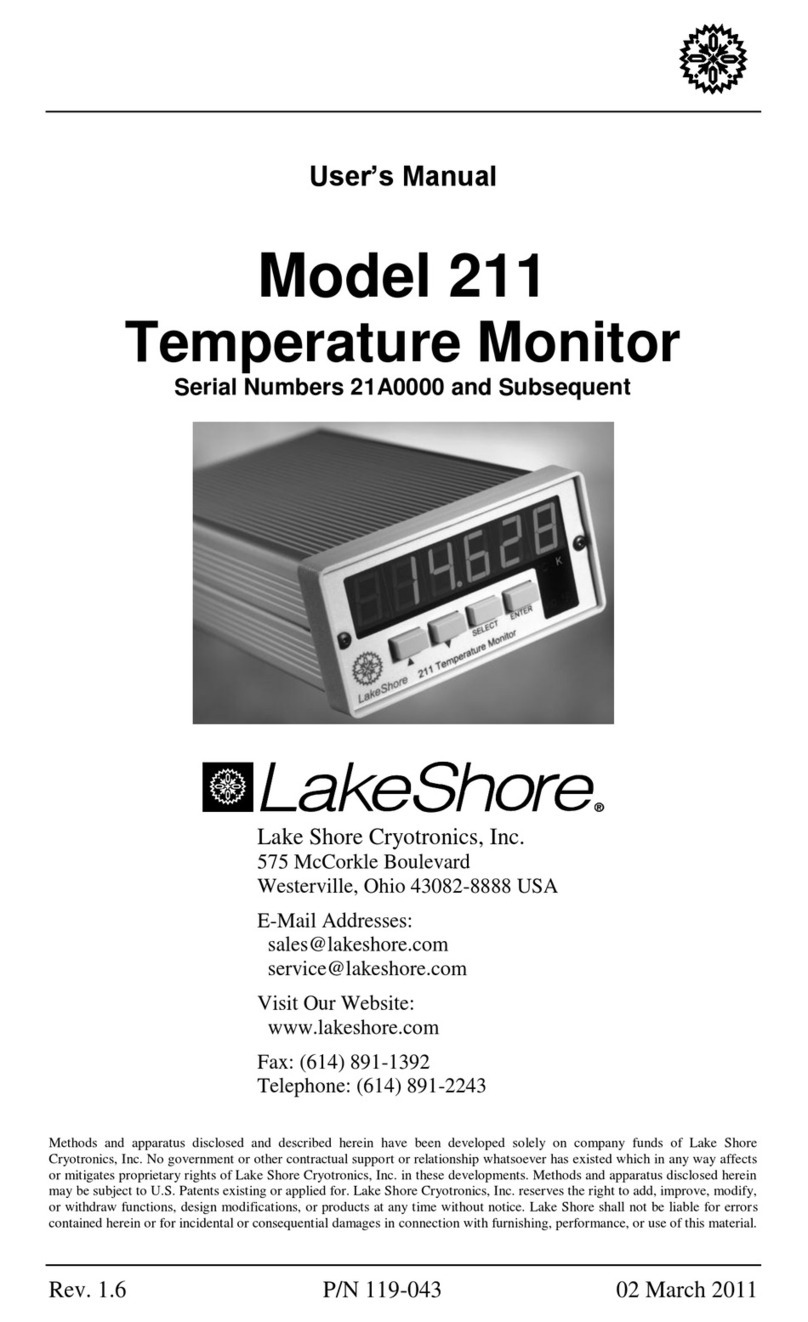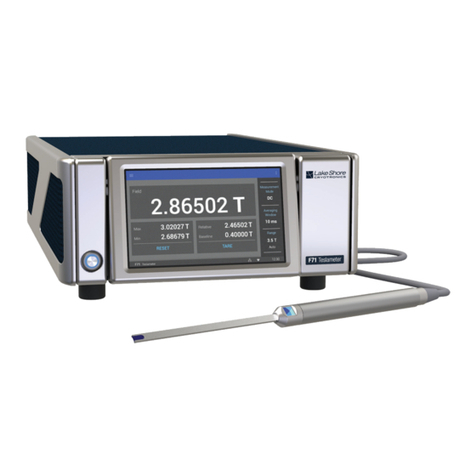
Model 74046 Magnetoresistance Insert Probe Option
LIMITED WARRANTY STATEMENT
WARRANTY PERIOD: ONE (1) YEAR
1.Lake Shore warrants that this Lake Shore product (the "Product")
will be free from defects in materials and workmanship for the War-
ranty Period specified above (the "Warranty Period"). If Lake Shore
receives notice of any such defects during the Warranty Period and
the Product is shipped freight prepaid, Lake Shore will, at its option,
either repair or replace the Product if it is so defective without charge
to the owner for parts, service labor or associated customary return
shipping cost. Any such replacement for the Product may be either
new or equivalent in performance to new. Replacement or repaired
parts will be warranted for only the unexpired portion of the original
warranty or 90 days (whichever is greater).
2.Lake Shore warrants the Product only if it has been sold by an autho-
rized Lake Shore employee, sales representative, dealer or original
equipment manufacturer (OEM).
3.The Product may contain remanufactured parts equivalent to new
in performance or may have been subject to incidental use.
4.The Warranty Period begins on the date of delivery of the Product or
later on the date of installation of the Product if the Product is
installed by Lake Shore, provided that if you schedule or delay the Lake
Shore installation for more than 30 days after delivery the Warranty
Period begins on the 31st day after delivery.
5.This limited warranty does not apply to defects in the Product
resulting from (a) improper or inadequate maintenance, repair or cal-
ibration, (b) fuses, software and non-rechargeable batteries, (c) soft-
ware, interfacing, parts or other supplies not furnished by Lake Shore,
(d) unauthorized modification or misuse, (e) operation outside of the
published specifications or (f) improper site preparation or mainte-
nance.
6. TO THE EXTENT ALLOWED BY APPLICABLE LAW, THE ABOVE WAR-
RANTIES ARE EXCLUSIVE AND NO OTHER WARRANTY OR CONDITION,
WHETHER WRITTEN OR ORAL, IS EXPRESSED OR IMPLIED. LAKE
SHORE SPECIFICALLY DISCLAIMS ANY IMPLIED WARRANTIES OR CON-
DITIONS OF MERCHANTABILITY, SATISFACTORY QUALITY AND/OR FIT-
NESS FOR A PARTICULAR PURPOSE WITH RESPECT TO THE PRODUCT.
Some countries, states or provinces do not allow limitations on an
implied warranty, so the above limitation or exclusion might not
apply to you. This warranty gives you specific legal rights and you
might also have other rights that vary from country to country, state
to state or province to province.
7.TO THE EXTENT ALLOWED BY APPLICABLE LAW, THE REMEDIES IN
THIS WARRANTY STATEMENT ARE YOUR SOLE AND EXCLUSIVE REME-
DIES.
8.EXCEPT TO THE EXTENT PROHIBITED BY APPLICABLE LAW, IN NO
EVENT WILL LAKE SHORE OR ANY OF ITS SUBSIDIARIES, AFFILIATES OR
SUPPLIERS BE LIABLE FOR DIRECT, SPECIAL, INCIDENTAL, CONSE-
QUENTIAL OR OTHER DAMAGES (INCLUDING LOST PROFIT, LOST DATA
OR DOWNTIME COSTS) ARISING OUT OF THE USE, INABILITY TO USE
OR RESULT OF USE OF THE PRODUCT, WHETHER BASED IN WAR-
RANTY, CONTRACT, TORT OR OTHER LEGAL THEORY, AND WHETHER
OR NOT LAKE SHORE HAS BEEN ADVISED OF THE POSSIBILITY OF
SUCH DAMAGES. Your use of the Product is entirely at your own risk.
Some countries, states and provinces do not allow the exclusion of lia-
bility for incidental or consequential damages,sothe above limitation
may not apply to you.
9.EXCEPT TO THE EXTENT ALLOWED BY APPLICABLE LAW, THE TERMS
OF THIS LIMITED WARRANTY STATEMENTDO NOT EXCLUDE, RESTRICT
OR MODIFY, AND ARE IN ADDITION TO, THE MANDATORY STATUTORY
RIGHTS APPLICABLE TO THE SALE OF THE PRODUCT TO YOU.
CERTIFICATION
Lake Shore certifies that this product has been inspected and tested in
accordance with its published specifications and that this product
met its published specifications at the time ofshipment. The accuracy
and calibration of this product at the time of shipment are traceable
to the United States National Institute of Standards and Technology
(NIST); formerly known as the National Bureau of Standards (NBS).
TRADEMARK ACKNOWLEDGMENT
Many manufacturers and sellers claim designations used to distin-
guish their products astrademarks. Where those designations appear
in this manual and Lake Shore was aware of a trademark claim, they
appear with initial capital letters and the ™ or ® symbol.
Kapton® is a trademarks of DuPont De Nemours.
Microsoft Windows®, and Excel® are registered trademarks of
Microsoft Corporation in the United States and other countries.
Copyright 2010 Lake Shore Cryotronics, Inc. All rights reserved. No portion of this manual addendum may be
reproduced, stored in a retrieval system, or transmitted, in any form or by any means, electronic, mechanical,
photocopying, recording, or otherwise, without the express written permission of Lake Shore.





































